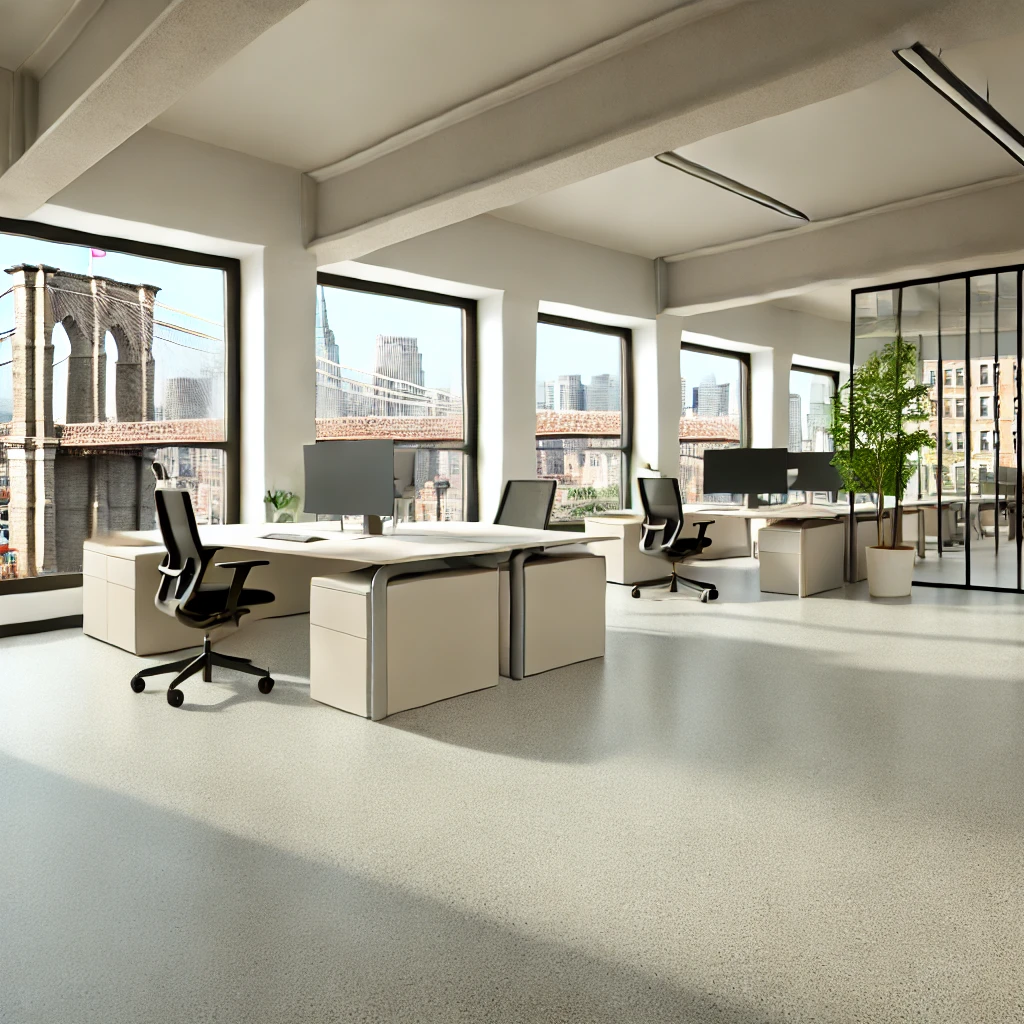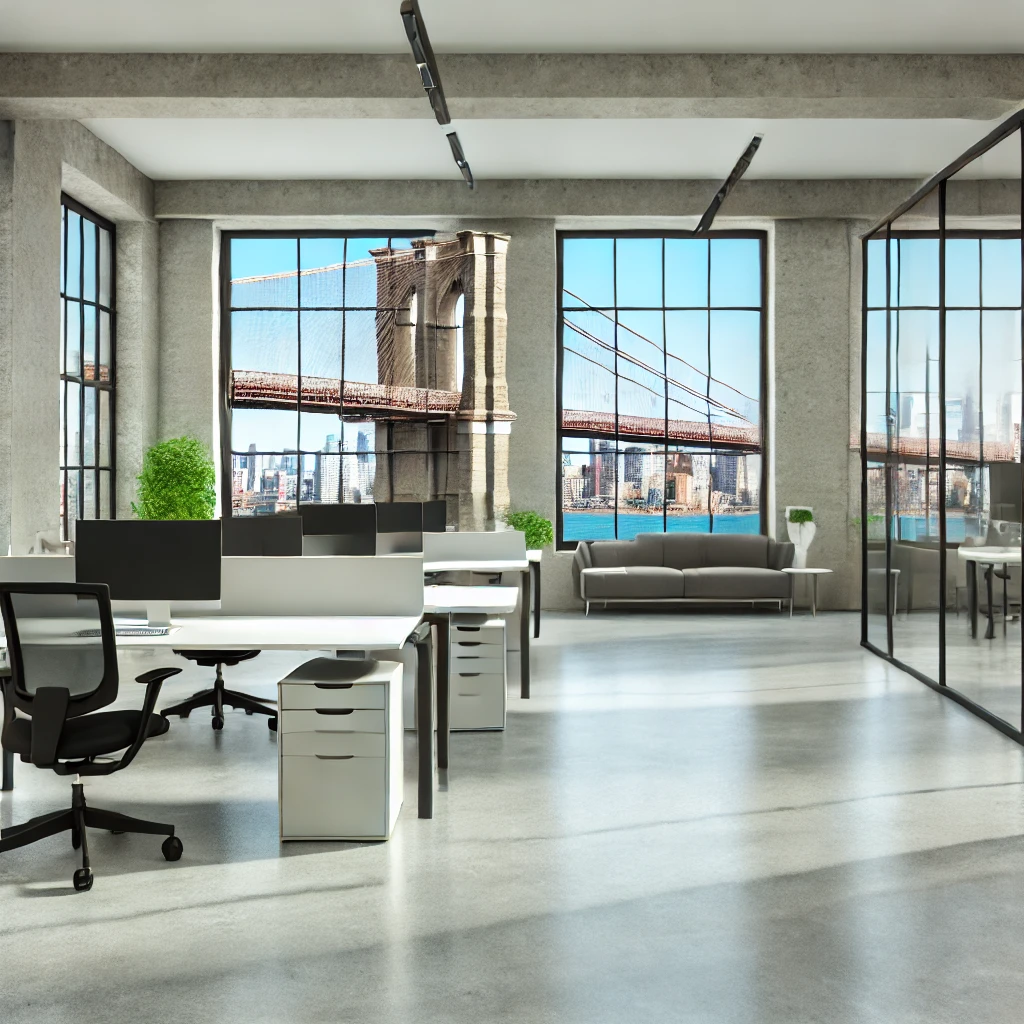When it comes to designing modern office spaces, flooring is one of the key elements that can make or break a space’s aesthetic, functionality, and longevity. Designers and architects in New York City are increasingly moving away from traditional flooring options like Vinyl Composition Tile (VCT) or carpet, favoring more innovative, durable, and design-friendly solutions such as microcement. This shift isn’t just about aesthetics but is driven by performance, sustainability, and modern workspace requirements.
The Rise of Microcement in Modern Office Design
Microcement is a thin, cement-based coating applied over surfaces to create a seamless, contemporary finish. Its adaptability and sleek appearance have made it a top choice for modern offices, where aesthetics meet functionality. Let’s explore why microcement is now a better choice for office spaces than traditional flooring options like VCT and carpet.
1. Durability and Longevity
Wear and tear are two of the main challenges VCTs and carpets face in commercial environments. VCT can crack, peel, or require frequent waxing to maintain its appearance. Similarly, carpets can stain, fray, or trap allergens and dirt, leading to high maintenance costs.
Microcement, on the other hand, is highly durable and resilient. It is designed to withstand heavy foot traffic without showing signs of wear. Unlike VCT or carpet, it doesn’t require constant upkeep. Once applied, microcement forms a hard, protective layer that resists impacts, scratches, and chemicals, making it an ideal choice for high-traffic areas like office lobbies, meeting rooms, and open workspaces.
2. Aesthetics and Design Versatility
In a city like NYC, where cutting-edge design and style are paramount, microcement offers unmatched versatility. Its seamless finish creates a clean, minimalist look that aligns with modern architectural trends. Microcement can be customized in various colors, textures, and finishes—ranging from matte to polished—allowing designers to tailor the flooring to the exact aesthetic of the office.
By contrast, VCT has limited design options, typically available in pre-made patterns and colors that can look dated. Carpet, though available in various styles, can still create a segmented look due to its seams and is prone to wear patterns that detract from the overall design.
Microcement offers an uninterrupted, uniform surface that enhances the feeling of spaciousness and modernity, making it a popular choice for open-concept offices and collaborative workspaces.

3. Ease of Maintenance
In today’s fast-paced work environment, businesses prioritize solutions that reduce downtime and maintenance costs. Carpets need regular vacuuming, deep cleaning, and stain removal, while VCT requires frequent stripping, waxing, and buffing to maintain appearance.
Microcement requires minimal upkeep. Its seamless surface is easy to clean with just water and mild detergents, making it an excellent choice for spaces where hygiene is critical, such as conference rooms, kitchens, and collaborative work areas. Additionally, its seamless finish means no grout lines or seams where dirt can accumulate, unlike with tile or carpet.
4. Sustainability and Environmental Considerations
As architects and designers focus more on sustainability, microcement is an eco-friendly option. Microcement can be applied over existing surfaces, reducing the need for floor demolition and minimizing waste. Its composition, based on natural materials like cement, water, and mineral pigments, is more environmentally friendly compared to the synthetic nature of VCT or the chemical treatments used in many carpets.
Moreover, the longer lifespan of microcement means fewer replacements and less waste over time. This aligns with the goals of many modern office projects that seek LEED certification or other green building standards.

5. Old Solutions Don’t Work Anymore: The Shift in Office Preferences
Traditional flooring solutions like VCT and carpet no longer meet the needs of modern office environments. Today’s offices prioritize flexibility, hygiene, and aesthetics; old solutions can’t keep up.
- Vinyl Composition Tile (VCT): While VCT was once a popular option for commercial spaces, it is now viewed as outdated due to its high maintenance requirements and susceptibility to damage. The need for constant polishing and the risk of cracking under heavy furniture make it less desirable for dynamic work environments.
- Carpet: While carpet may offer some acoustic benefits, it falls short in cleanliness and durability. Stains, spills, and wear patterns are inevitable in high-traffic office areas, and the constant maintenance it requires often proves costly and time-consuming. In addition, carpet’s potential to trap dust and allergens can negatively impact indoor air quality, a significant concern in today’s health-conscious workspaces.
Microcement, by contrast, offers the ideal solution to these problems. Its seamless, non-porous surface doesn’t trap dust or allergens, and its industrial-strength durability ensures that it looks as good in year 10 as it does in year one.
6. Modern Office Trends Demand New Solutions
The evolution of office design has shifted towards creating open, collaborative, and adaptable spaces. Microcement is ideally suited to these trends. Its ability to create large, continuous surfaces without joints or seams makes it ideal for open-plan layouts. The sleek, modern appearance of microcement complements the minimalist, tech-driven aesthetic seen in many contemporary office designs.
In addition, more companies are focusing on creating healthy, safe, and clean environments for their employees. Microcement’s ease of cleaning and resistance to mold, bacteria, and dust make it a preferred flooring option for businesses prioritizing employee well-being.

Technical Comparison: Microcement vs. VCT and Carpet
| Feature | Microcement | VCT | Carpet |
|---|---|---|---|
| Durability | High | Moderate, prone to cracking | Moderate, stains and wears out |
| Maintenance | Low, easy to clean | High, requires frequent waxing | High, requires regular cleaning |
| Design Flexibility | Customizable, seamless | Limited patterns/colors | Multiple styles, but segmented |
| Lifespan | 20+ years | 5-10 years | 5-8 years |
| Sustainability | High, eco-friendly | Low, synthetic materials | Moderate, often synthetic |
| Application | Can be applied over existing surfaces | Requires substrate prep | Requires removal and replacement |
Conclusion: Elevate Your NYC Designs with Microcement
For architects and designers in New York City, microcement offers an unbeatable combination of durability, aesthetics, and sustainability. Its ability to meet the demands of modern office environments—while providing a sleek, stylish finish—makes it a top choice for forward-thinking projects. By choosing microcement, you’re not just installing a floor but investing in a solution that enhances the longevity, performance, and appeal of the spaces you create.
Embrace the future of office design with microcement, and leave behind the outdated limitations of VCT and carpet. Contact us today!
